
| Language | From $0.00 |
| Release Date | June 1, 1890 |
| Genre | Classics |
| Author | Oscar Wilde |
| File Size | Random House: Modern Library |
| Rating | (4.12) |
The Picture of Dorian Gray tells the story of a young man named Dorian Gray, whose portrait is painted by artist Basil Hallward. When Dorian meets Lord Henry Wotton, he becomes obsessed with the idea of remaining youthful and beautiful forever, while his portrait ages and reflects his sins. As Dorian indulges in a life of hedonism and debauchery, the consequences of his actions become evident in the portrait, leading to a tragic end.
Dorian Gray is a handsome, vain, and wealthy young man who becomes the subject of Basil Hallward’s portrait. Influenced by Lord Henry Wotton, Dorian becomes obsessed with maintaining his youth and beauty, leading him down a dark path of hedonism and immorality.
Basil Hallward is a talented artist who becomes infatuated with Dorian Gray’s beauty. He paints the portrait that ultimately serves as a symbol of Dorian’s corruption and downfall.
Lord Henry Wotton is a cynical and manipulative aristocrat who introduces Dorian to a life of hedonism and influences his moral decline.
The novel explores the relationship between beauty, art, and morality, with Dorian’s obsession with his own beauty leading him to pursue a life of pleasure at the expense of his morality.
The novel examines the consequences of moral corruption and the dangers of being influenced by others, as seen in Dorian’s relationship with Lord Henry Wotton.
The Picture of Dorian Gray raises questions about the relationship between art and life, with the portrait serving as a symbol of Dorian’s inner self and the consequences of his actions.
Wilde’s writing is characterized by his wit and eloquence, with clever dialogue and descriptions that highlight the novel’s themes and characters.
The novel is told in the third person, with a focus on Dorian Gray’s perspective, allowing the reader to witness his moral decline and the impact of his choices.
Wilde uses irony and satire throughout the novel to criticize Victorian society’s obsession with appearances and superficiality, as well as its moral hypocrisy.
Upon its publication in 1890, The Picture of Dorian Gray was met with controversy and accusations of immorality due to its exploration of hedonism and moral corruption. However, the novel has since become a literary classic and is widely regarded as one of Wilde’s greatest works. The story has been adapted into various films, stage productions, and other media, demonstrating its enduring appeal and influence.
The Picture of Dorian Gray is a compelling exploration of morality, beauty, and the dangers of influence. Its rich language, memorable characters, and thought-provoking themes make it a timeless classic that continues to captivate readers and inspire new adaptations.